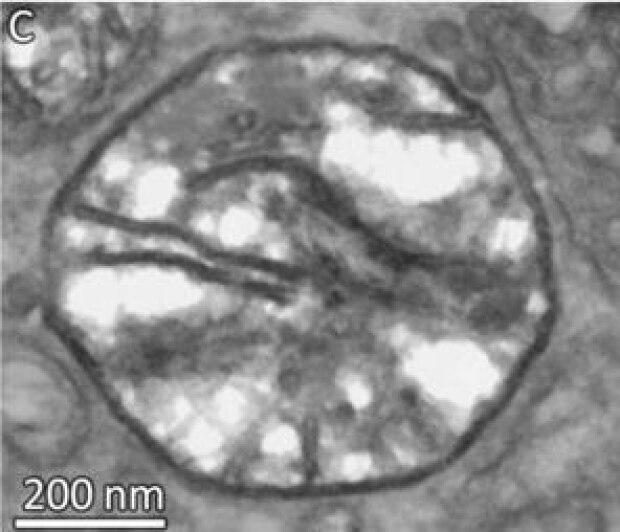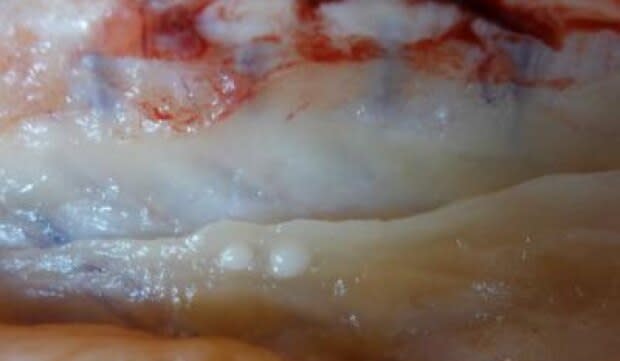Scientists discover 1st animal that doesn't breathe oxygen
Scientists have discovered something they didn't think existed: an animal that can't breathe oxygen, and obviously doesn't need to.
That animal is a parasite called Henneguya salminocola, distantly related to jellyfish. It lives in the muscles of salmon and trout, causing unsightly little white nodules known as "tapioca disease."
The parasite has just 10 cells and is smaller than many of the cells in our bodies, but it has an extraordinary superpower — the ability to live without the machinery to turn oxygen into energy, researchers reported this week in the journal Proceedings of the National Academy of Sciences.
"In a way, it changes our view of animals," said senior author Dorothée Huchon, a zoology professor in the Faculty of Life Sciences and the Steinhardt Museum of Natural History at Tel Aviv University, who worked with collaborators in Israel, the U.S. and Canada.
While many microbes have evolved the ability to live without oxygen, animals tend to be much more complex, with many different kinds of cells and tissues combined in one organism.
As far as scientists knew until now, all animals were powered by organelles called mitochondria, which convert sugar and oxygen into energy through a process called respiration, and have their own "mitochondrial" genes.

Huchon was sequencing the genomes of Henneguya extracted from a Chinook salmon and related fish parasites when she noticed Henneguya's mitochondrial genes were missing.
"At first I thought, 'Oh, we made an error,'" she said.
But when the cells were stained with a dye that makes DNA fluorescent, only the cells' nucleus was stained — no mitochondria appeared, as they did in related fish parasites.
The mitochondrial DNA wasn't the only thing missing. So were genes for many enzymes involved in respiration normally found in the nucleus.
But where does the energy come from?
The cells still had organelles that looked like mitochondria and made other enzymes that mitochondria make. They just didn't do respiration anymore.
What the researchers don't yet know is how the organism gets energy without breathing oxygen.
Some microbes that don't breathe oxygen breathe hydrogen instead, but there's no evidence Henneguya does this.
Some parasitic microbes don't breathe themselves, but steal energy molecules called ATP from their hosts.
"We believe this is what our parasite is doing," Huchon said.

Henneguya and its relatives spend part of their life cycle in a fish and part of their life cycle in a worm, although each organism is specialized in terms of what kind and part of the fish it chooses and what kind of worm it lives in. In the case of Henneguya, it lives in the muscles of coho, chinook, pink, sockeye and chum salmon as well as rainbow trout.
While it's related to jellyfish, it doesn't look anything like one. In the spore stage, it is somewhat tadpole-like.
"Otherwise, it's just a big blob," Huchon said.
The parasite doesn't appear to bother the fish much, she said, but tapioca disease can make its meat unmarketable and also cause the meat to spoil more quickly, making it a nuisance for the seafood industry: "No one wants to eat salmon full of white dots inside."
She suspects that both the salmon muscle and Henneguya's host worm are low-oxygen environments, making the ability to breathe oxygen useless to the organism.

Andrew Roger, a Dalhousie University biology professor who was not involved in the study but was part of a team that discovered the first eukaryote (organism with complex cells) without mitochondria, said he was surprised by the discovery, but found the evidence convincing.
"There was a belief that all animals should have mitochondrial DNA and be able to do aerobic metabolism," he said. "This one can't. It changes the textbook account of what you see in the animal kingdom."
However, he believes "it's inevitable" that scientists will find more animals like Henneguya among those that have adapted to living in places with almost no oxygen, such as some parts of the ocean floor.
In fact, scientists have already proposed that one such group of animals called loriciferans can do that, and had some evidence that this was the case, although not as much or as detailed as for Henneguya.
Roger says animals can actually use an oxygen-free process to produce energy from sugar, but it's far less efficient. He suspects this may be what Henneguya is doing.
Patrick Keeling, a biology professor at the University of British Columbia has also studied parasitic microbes that don't breathe oxygen, but wasn't involved in the research.
He said it's hard to prove that something doesn't exist, but said Huchon and her team have done that.
He added that the ability to live without breathing oxygen has evolved many times among microbes in environments with little or no oxygen.
"In a way, it's not surprising," he said. "But it's pretty cool that animals can do it too."

